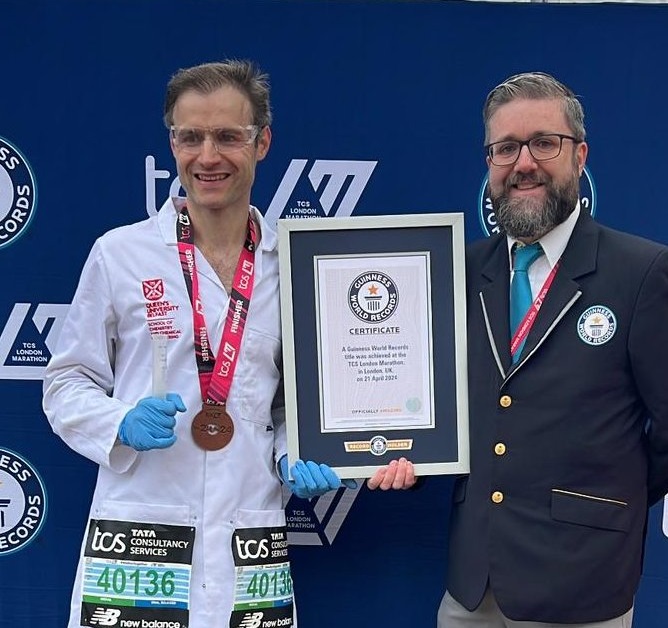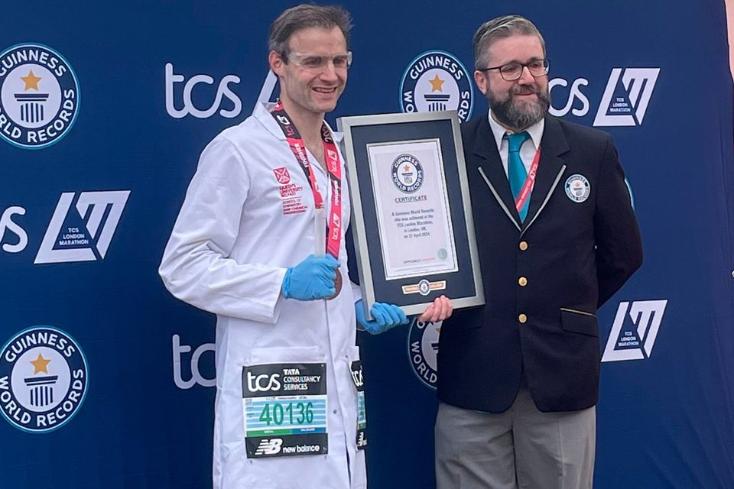"I ran a marathon in full PPE"
Congratulations to our own Stephen Cochrane who has just broke the record for running the London Marathon dressed as a scientist in full PPE and has made it into the Guinness book of records.

More from Stephen himself:
As a PhD student I would often complain about how sweaty I would get during the hot summer months. Safety glasses, a lab coat, full length trousers and chemically resistant gloves are designed to protect us from accidental splashes in the lab, not to keep us cool. Flash forward to 21 April 2024. I’ve just emerged from Blackfriars Underpass, having ran 38 of the 42.2km of the London Marathon in full PPE. Exhausted, overheated and covered in sweat, I swore to myself that I’d never complain about PPE in a lab again!
I’m a bioorganic chemist at Queen’s University Belfast, where my research focuses on development of new antibiotics. Outside of work, my major hobby is running, and to date I’ve completed 15 marathons, including Berlin, Boston, Chicago (where I set my personal best of 2 hours 36 minutes) and London. Running fast marathons requires high weekly mileage and during marathon training blocks I average 70–80 miles per week. That’s 60–90 minutes daily and 120–180 minutes on Saturday.

Depending on how I’m feeling, I’ll either listen to audiobooks while running or use it as thinking time. In fact, I do some of my best scientific thinking while running as there are no distractions, and the rush of endorphins gets me excited thinking about research. A lot of the conceptualisation for my successful ERC Starting Grant application was done while pounding the pavement. And if my group had a pound for every time I started a conversation with ‘When I was running this morning…’ they’d be quite well off!
When I found out in December 2023 that there was a Guinness World Record (GWR) for the fastest marathon dressed as a scientist, I knew I had to attempt it. I chose the 2024 London Marathon as my target, which has GWR adjudicators present, meaning new records can be ratified on the day.
The dress requirements for the record attempt were full length trousers, a lab coat, gloves and safety glasses, and I also had to carry a piece of scientific equipment. These had to be worn for the entire race and if I had dropped my equipment, I couldn’t restart before picking it up again. I’m very glad that didn’t happen in the sea of thousands of runners! I did think about asking why I couldn’t wear my regular running gear as I’m a scientist in any attire, but the GWR adjudicators aren’t known for their flexibility.

Thankfully I could wear my carbon-plated racing shoes. These are an amazing example of materials chemistry, where a carbon-fibre plate is placed in the midsole and surrounded with a heavy amount of proprietary foam, both of which maximise energy return while running, making you faster.
How did the race go? Well, dressed in my regular lab attire of lightweight trousers, a polyester and cotton lab coat, blue nitrile gloves and safety specs (and armed with my trusty 50ml measuring cylinder), I set off from Greenwich Park seeking GWR glory. My plan was to run ~15s/km slower than my personal best pace to account for running in costume, and I controlled this well. However, I quickly learned that full PPE is not made for running marathons! I was rapidly overheating after only a few kilometres and this is where I used previous marathon experience and chemistry to help me out.
To fuel exercise, our bodies produce the molecule ATP through aerobic and anaerobic respiration. Anaerobic respiration produces lactic acid as a by-product, and if it is produced faster than it can be cleared it acidifies our leg muscles, causing discomfort and the heavy legs many get in the final 10km of a marathon. Above a certain percentage of our maximum heart rate, known as our lactic threshold, it exponentially accumulates. If this happens too early in a marathon, you’re in for a hard day at the office. So, at every water station, I took a few gulps of water and doused myself with the rest to reduce my heart rate and limit lactic acid build-up. I started doing this a bit too late so did slow in the final 5km due to lactic acid accumulation.
But I still crossed the finish line in 2 hours 48 minutes and 51 seconds, knocking almost seven minutes off the old record. As I crossed the line, I felt mostly relief that I could take my sweaty gloves off!
Through this record attempt, I hoped to promote chemistry as an interesting subject and show that academics have a fun side. After the race I was inundated with media requests and was even interviewed by regional ITV News, so like to think that my #ChemistryofRunning campaign was a success. Will this encourage more people to study the subject at university? Time will tell, but at least it will jog their memory about the importance of chemistry!
More on Stephen and his work here : https://www.cochranelab.com/
